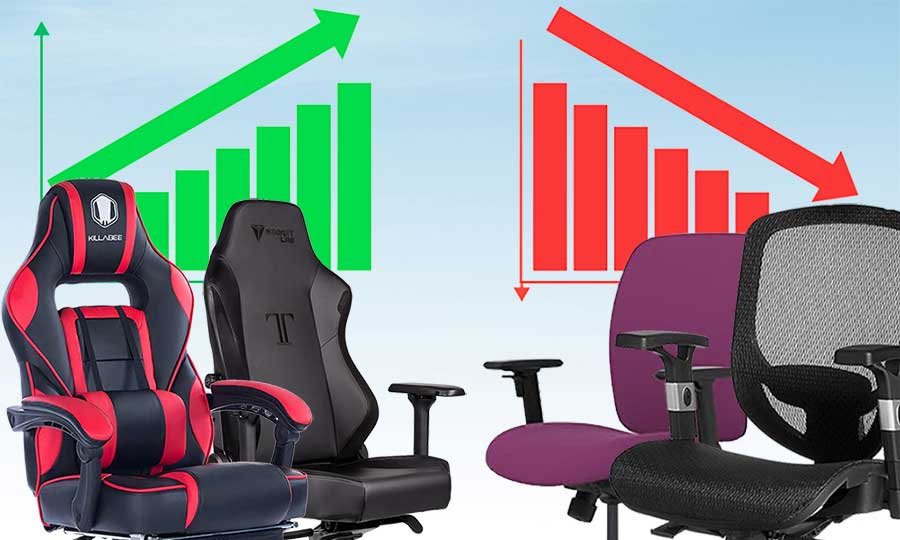A good chair is important for people who work at desks for long periods. But in 2023, U.S. schools still use cheap, non-adjustable plastic or wooden chairs. Students must sit in these for long periods without movement breaks. This history of school seating shows article shows standards haven’t evolved since 1635. In contrast, ergonomic support for kids in consumer markets is robust. The key takeaway: parents need to teach their kids how to sit in a healthy way. If they don’t help their kids develop healthy posture habits, no one else will!
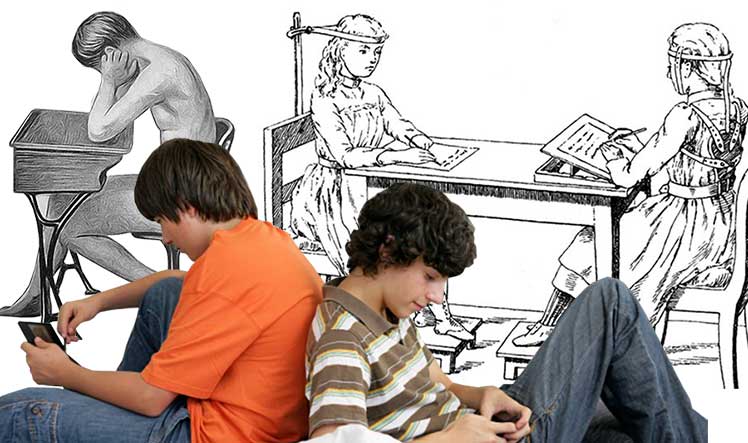
American school systems place a low priority on the physical needs of their students. Many leading scholars have tried to foster change, like Harvard ergonomist Jack Dennerlein. He noted that most schools force students to sit all day in cheap non-ergonomic chairs(1).

“These chairs cause long-term problems for students.” Common problems include “neck and back damage, headaches and an eventual lack of focus.”
Posture Affects Cognitive Performance
There’s a clear link between posture and cognitive performance. “We’ve seen in adults that if you put them in the right chair, their performance increases,” Dennerlein also said(2). “Is the same true for children? I can’t see why not.”
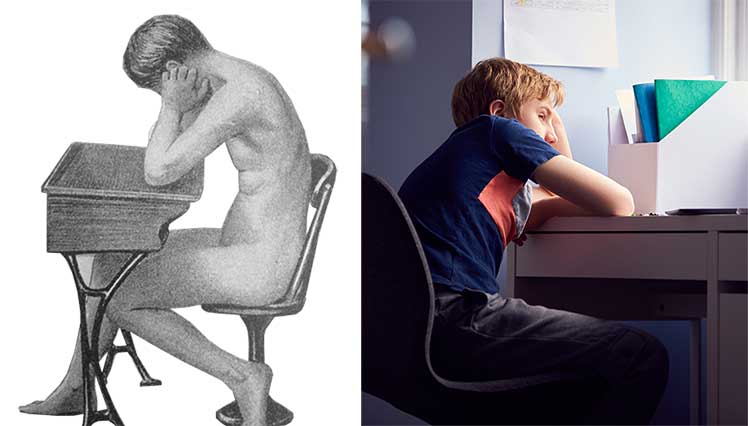
Dr. Roger Sperry won the Nobel Prize for Brain Research in 1981. He made this(3) famous quote:
“90% of the energy output of the brain is used in relating the physical body to gravity. The more distorted a person is, the less energy is available for thinking…”
Slouching overworks muscles, burning insane amounts of energy. It also clogs circulation and diminishes oxygen intake. Combined, this reduces the flow of synaptic connections in the brain(4). These are responsible for memory, concentration, and transmission of information in your brain.

In fact, many studies show a connection between posture and cognitive performance(5). Those who sit with good posture tend to be more alert and engaged. In contrast, sitting with poor posture increases the risk of weight gain, depression, and anxiety.
Posture Evolution In American Schools
Ergonomics is the study of people in their working environment. Ergonomic scientists strive to optimize workspaces to fit the user. The point is to reduce discomfort and boost productivity. This approach places the well-being of the user as the highest priority.

Most schools ignore ergonomics and use a one-size-fits-all approach to furnish classrooms. Because school seating hasn’t changed in so long, most students have normalized living with stiff joints, lethargy, and lower back pain.
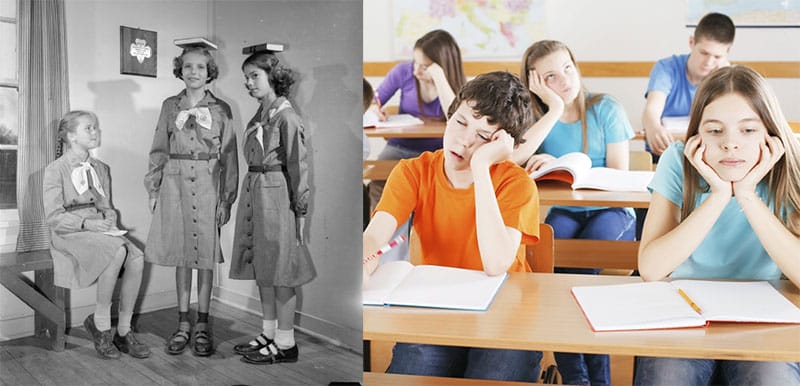
This section outlines the history of ergonomic intelligence in America. This timeline comes from The Rise and Fall of American Posture(6).
1635-1850: Crude Seating
America’s first public school opened in 1635(7). Instead of academics, the earliest schools taught about family, religion, and community.
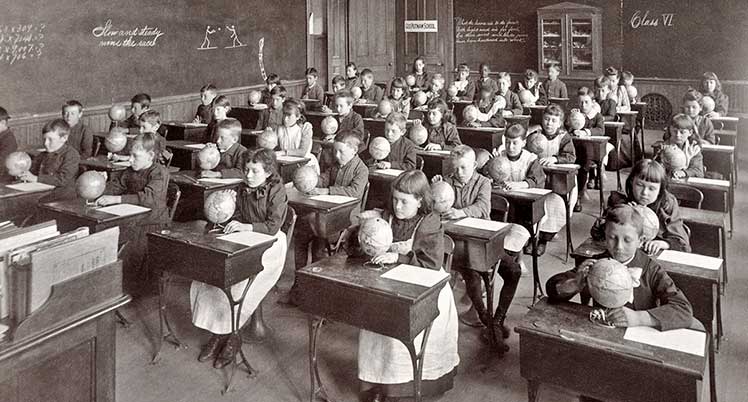
Academic subjects entered the picture around 1850. Around this time, common schools emerged(8). Those educated students of all ages in one room. Parents paid tuition or commodities to support the teacher.
School life in the 1800s
Most schools had summer and winter sessions. Girls and youngsters usually attended the summer session while boys worked the fields.

In winter, boys would go to school, while girls would stay home to help out with chores. Conditions inside these single-room schools paid no mind to student wellness.
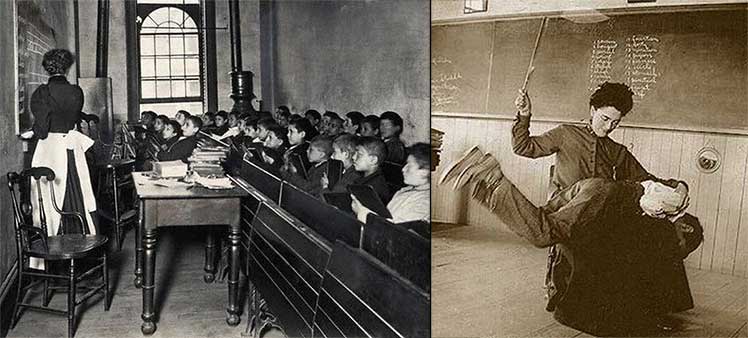
Kids were stacked into wooden benches for hours at a time. Those who acted up would literally get beaten into submission.
1850-1898: Mandatory School, Strict Posture
Compulsory school attendance laws first passed in Massachusetts in 1852. By 1900, thirty-two states had passed compulsory education laws. By 1930, all states had done so.
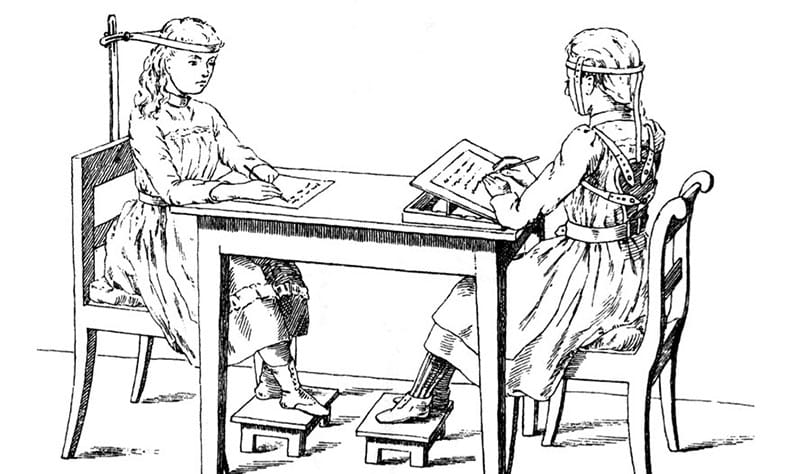
Advocates of this change argued it would help to close the wealth gap. Opponents saw it as an infringement of rights over how to raise their kids(9).
They also argued that the nature of the classroom was unnatural. It forced kids to distort their bodies by sitting at desks for 6 hours every day.
Indeed, there were early signs of trouble. In 1890, a leading pediatric journal claimed that over 50% of American kids had deformed spines.
1898-1943: Rigid Posture Obsession
In response to widespread spinal issues, sitting straight became a high priority. Poor posture, flat feet, and curved spines became synonymous with weakness(10).
In 1898, the American Physical Education Review launched(11). One of its missions was to spread awareness about good posture habits. Early articles noted medical concerns about posture in schools. Sample passage:
“With his introduction to school life, the child’s physical troubles begin. He is made to sit still from 3 to 6 hours, with but momentary rests at long intervals, the play instinct (expressed by recurrent attacks of the ‘fidgets’) has to be sternly suppressed by the teacher…”
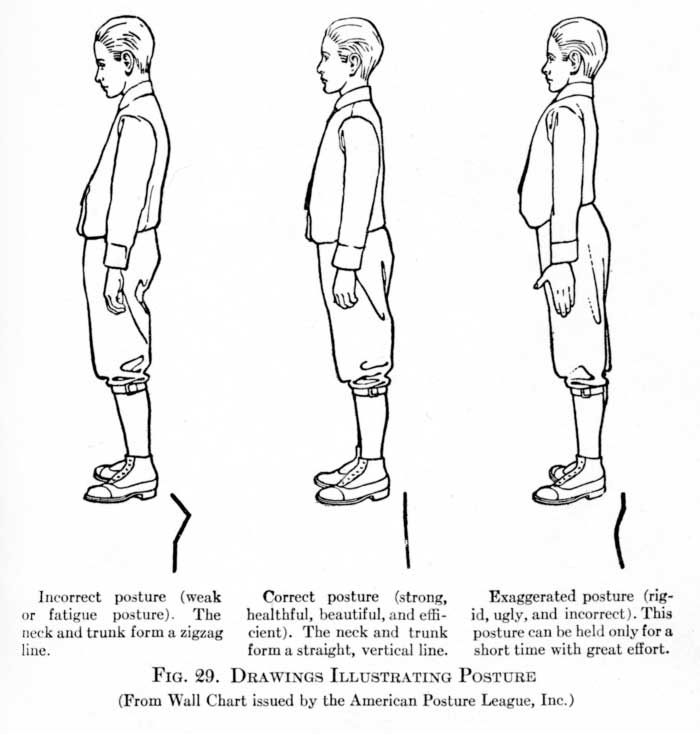
In 1914, the American Posture League was formed by educator Jessie Bancroft. Per The Rise and Fall of American Posture, it aimed to merge business with science. Based on posture research, the League gave ideas to manufacturers for new furniture and footwear.
Posture Training Added To School Curricula
A year earlier, Bancroft had published The Posture of Schoolchildren(12). The League became the vehicle to push posture correction tips featured in the book.
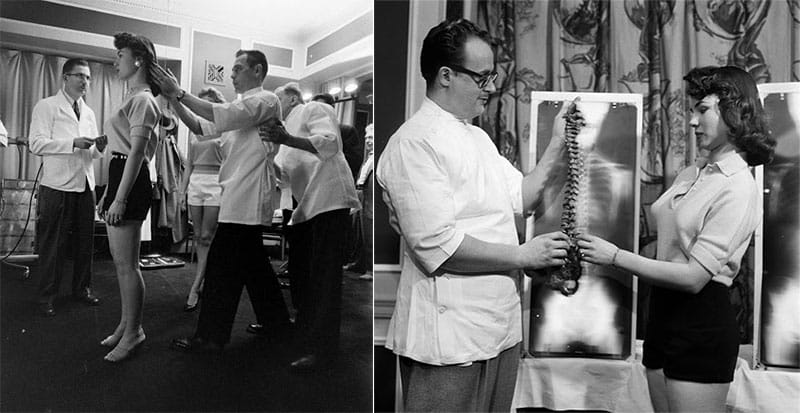
Educators adopted the book’s teachings en masse. Schools around the country began assessing posture and training students in need of correction. Teachers went on the warpath, making lives miserable for slumping kids until they ‘straightened up’.
Thus, posture became associated with good manners. Poor posture became a sign of poor personal values. Doctors began to ‘diagnose’ students by photographing them naked.
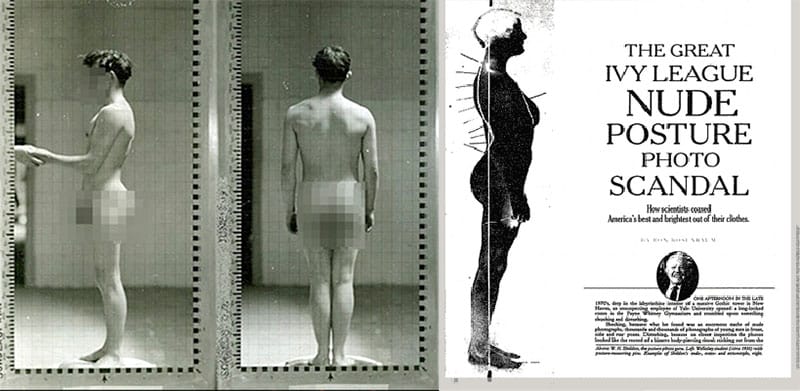
Soon after, elite colleges also started photographing student applicants nude to assess their posture(13).
The posture craze also influenced home life. By the 1930s, government pamphlet dispersal pressured parents to become involved. As a result, kids began to adopt good posture habits at home as well as in school.
1940-1960: Posture Obsession Relaxes
In the early 1940s, new disputes about the priority of posture emerged. Instead of locking into rigid postures at all times, people began to relax more. Family gatherings around the radio became opportunities to be flexible with the body.
Posture became part of a larger complexity in the choices that were now essential in the presentation of the self. Retreat occurred on almost every front:
- >1943: American Posture League closed.
- 1950: most posture clinics had closed.
- 1955: Rebel Without a Cause made James Dean’s exaggerated lounging a symbol of youthful defiance.
- 1960s: Ivy League schools started ending their nude posture photo programs.
1960s: Good Posture Is For Nerds
By the 1960s, Ivy League schools stopped taking nude posture pictures. This era favored consumerism, sexuality, and suppleness. Standing up straight was for nerds and “squares”.

Moving forward, posture was no longer a measure of character or social worth. During the posture craze, doctors’ influence depended on social support more than research.

With posture no longer a measure of social worth, posture doctors began to lose their clout.
1970s-1990s: Postural Indifference
This era saw the rise of computers, and “repetitive stress” injuries like “tired neck syndrome.” But with posture studies out of fashion, research focused on developing artificial back supports.

This was largely pushback against a previously overblown paradigm. As a result, many modern doctors are unaware of the rich (but flawed) body of posture literature of the past. This brings us full circle back to the seating standards of the pioneer era.
Rise and Fall of American Posture conclusion: posture’s deep association with stiffness underpinned its demise. In its place, consumer, athletic, and sexual standards trended towards suppleness and a more open bodily demeanor. So, after a noteworthy run in American personal life, a key form of self-restraint eased. Posture bent to the times.
2021: School-from-home Injuries
When the pandemic hit, millions of American students were thrust into online classes. As a result, health care providers began reporting a surge of reported injuries.

Several chiropractors suggested to the Advisory Board the same root cause(14). Millions were suddenly spending long periods working on kitchen counters, beds, and sofas.
When short-term morphed into long-term, mild discomfort turned into serious pains. As a result, reported injuries surged.
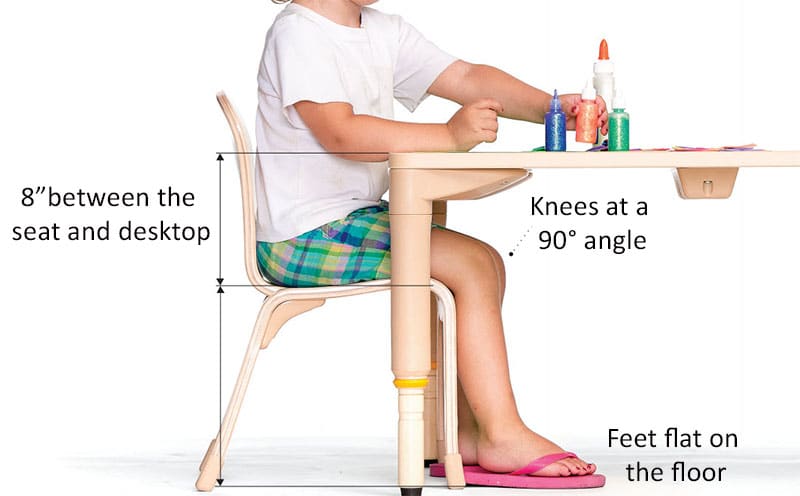
Ergonomist Nikki Weiner gave the Advisory Board a technical reason for mounting health woes: when working on a sofa, bed, or stool, people are unable to hold a “neutral position”.
Neutral Posture 101
With over a century of development, ergonomic standards in academia are still at pioneer-era levels. This is despite healthy sitting standards being well-documented for quite some time.
Seeking the Optimal Posture of the Seated Spine(15) was published in 2001. It compiled leading studies in the field and came to the clear conclusion that the healthiest way to sit is in fluid, neutral postures.

Today, all ergonomic chairs come with ergonomic components designed to support fluid, neutral postures. That means sitting with planted feet and a straight upper back.

In broader terms, neutral sitting defines as:
- Arms at the sides, with forearms parallel to the floor.
- Feet planted firmly on the floor.
- Hips angled slightly above the knees.
- Straight upper back and neck.
‘Fluidity’ means not sitting in any fixed position for too long. Any longer than five minutes in any rigidly fixed position will strain muscles.
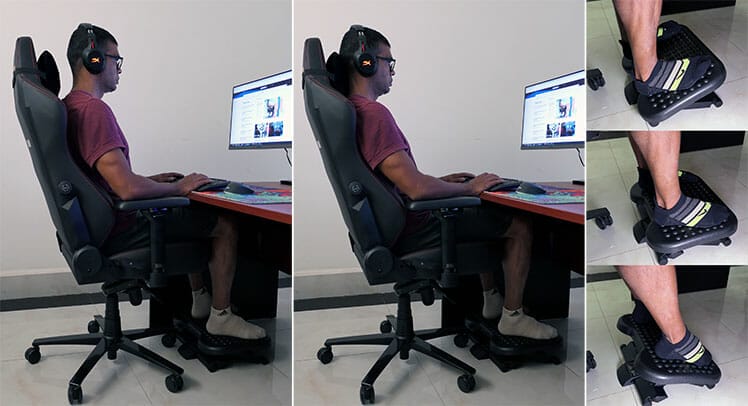
The simplest way to move in any type of chair is to shift your position every few minutes. The big advantage of ergonomic chairs is that they give you more opportunities to move.
Ergonomic chairs support neutral postures
To qualify as ‘ergonomic’, a chair needs three adjustable components. Adjustable lumbar, adjustable armrests and a reclining backrest are essential. Check this article for a breakdown of each component’s physiological benefits.
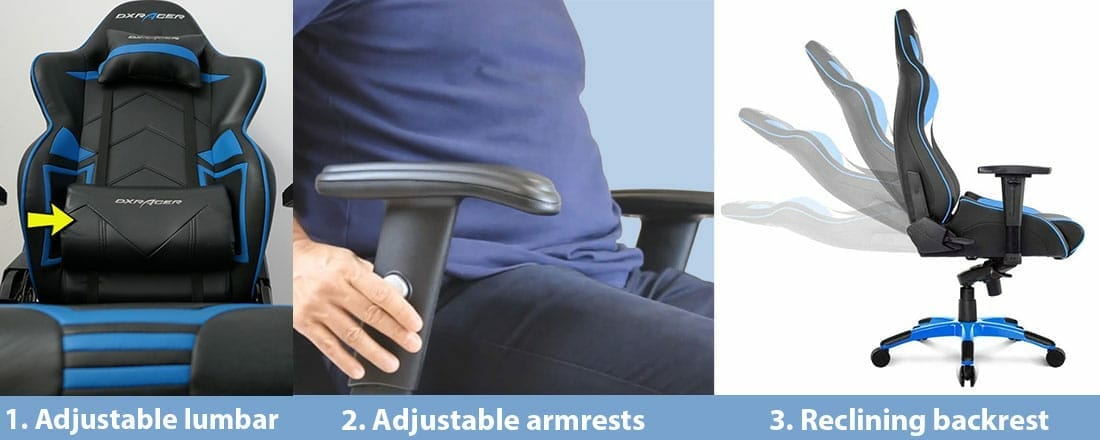
The Handbook of Human Factors and Ergonomics is the reference for ergonomic researchers. It corroborates the neutral sitting concept with some specific tips. These tips clarify the role of the essential ergonomic components:
- Seat height: adjust your chair’s seat so that the feet rest flat on the floor. If too short, add a footrest.
- Seat depth: the user should sit far enough back to use the backrest. Then, there should be a gap between the back of the knees and the chair’s lip.

- Lumbar support: slight pressure in the lumbar area keeps the back straight. A chair’s lumbar support should be adjustable to around 6-10 inches (15-25 cm) above the seat height.
- Backrest angle: switching through a range of angles reduces fatigue. An ergonomic backrest should recline to at least 115 degrees.
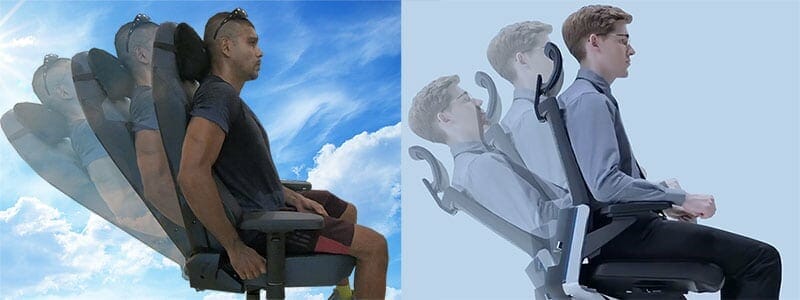
For a deep plunge into the scientific studies behind healthy sitting tactics, check this feature:
Ergonomic Blueprint For K-12
Today, ergonomic ignorance is a convenience for educators. Most schools are severely underfunded. Ignoring student welfare meets budgetary bottom lines.
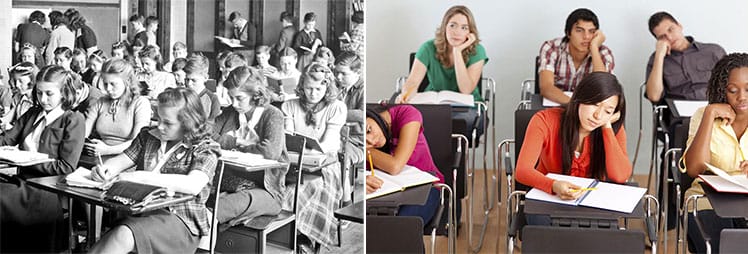
For example, the Toronto school board budgets $148.50 per secondary school student. That covers all general needs including furniture, textbooks, field trips, and athletic fees.
In New Jersey, the total ‘equipment cost’ per student was $33 per student in 2016. That covers furniture plus computers, tools, trucks, cars, and buses.
This is why schools buy furniture that’s cheap and durable. The problems with this approach are ignored. From a University of Manitoba study:
- 83% of elementary school kids use desk-chair combinations not suitable for their height.
- Elementary school students spend around nine hours sitting in school per day.
- Most school furniture completely ignores orthopedic-physiological realities.
No solutions to this problem exist. However, a few existing chair models can serve as blueprints for new solutions. Here’s a summary:
Pre-school
Before a baby can sit, it must learn how to crawl. That develops limb strength. By around eight months old, a child is strong enough to start sitting upright.
By age three, a child’s body will double in height and quadruple in weight. Between 3-4 years old, a child should be able to sit and keep focus for around 10 minutes.
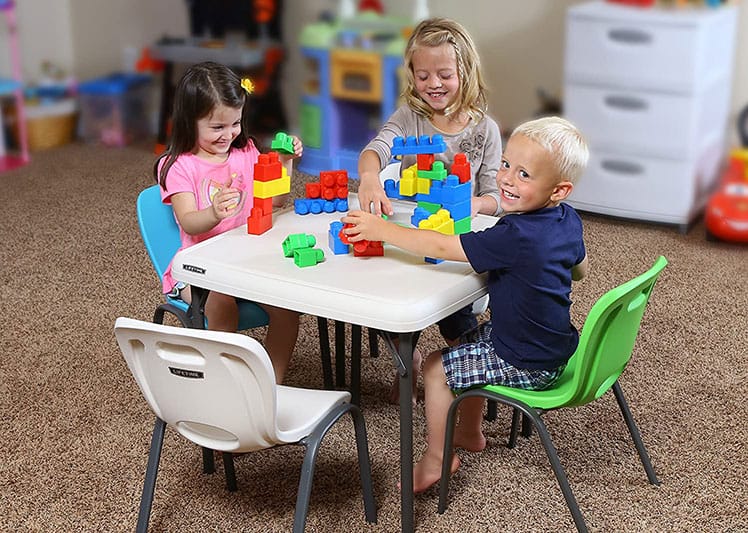
For short periods of sitting, basic furniture does the job. As an example, the Lifetime Kids’Stacking Chair comes in a 4-pack on Amazon for $104.19. But notice the kid on the right, in the green chair. It’s easy to see his feet dangling off the floor.
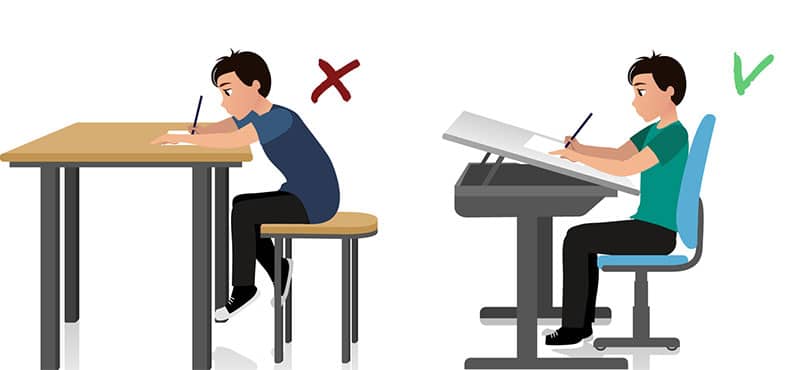
With a basic understanding of neutral sitting fundamentals, any educator should spot that. They would also understand that dangling feet means a kid needs a footrest.
4-12: Ergonomic Kids’ Chair
The best ergonomic chairs for kids share a similar design concept. All promote neutral postures with an emphasis on ‘feet planted flat’. These chairs have height-adjustable footrests to keep the feet planted.
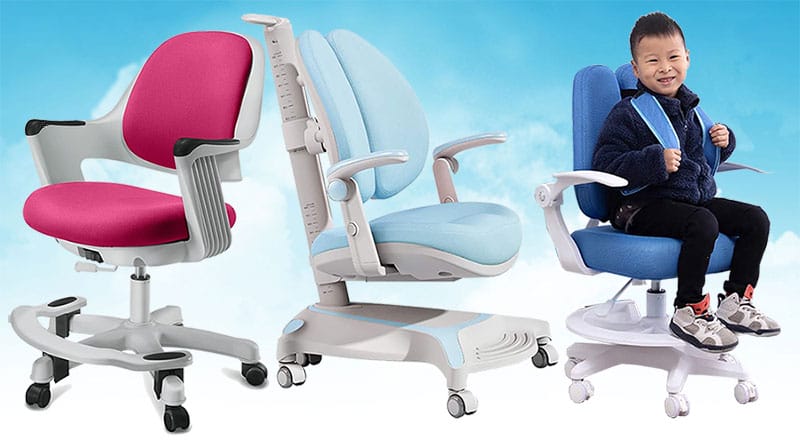
For use in schools, the Sidiz Ringo chair is our suggested prototype. On Amazon, the Ringo chair costs $289.00.
That’s too expensive for most schools. Even so, a stripped-down version of the Sidiz chair would work perfectly. Whoever designs one for schools could make a killing.
Sidiz Ringo features
The Ringo is rated to support kids aged 6-13 (grades 1-7). The footrest has four adjustment levels. Step 1 (smallest) supports users from 3’6″ to 4’1″ (106-124 cm). The largest Step 4 supports sizes from 4’9″ to 5’2″ (144-157 cm).

- Functionality: depth-adjustable sliding seat; height & depth adjustable backrest; 4 seat & backrest sync levels; optional footrest.
- Comfort: padded seat and backrest.
- Extras: adjustable footrest is included.
- Warranty: 30-day money back guarantee; 3-year warranty.
The Ringo also has a lockable 360°. Unlock to let the chair swivel. Lock into place when it’s time for students to focus. Check out comparable models in this review:
Best ergo chairs for kids 4-12
The Sidiz Ringo is available on Amazon for $289.00.
Long-term Effects Of Poor Posture
Q: If slouching is so bad for health, how have schools gotten away with it for so long?
A: Physical issues caused by slouching usually manifest later in life.
According to Wolff’s Law, bones develop based on the loads the body places on them. Poor sitting habits early in life can alter bone development. Later in life, these manifest as issues like arthritis or osteoporosis.
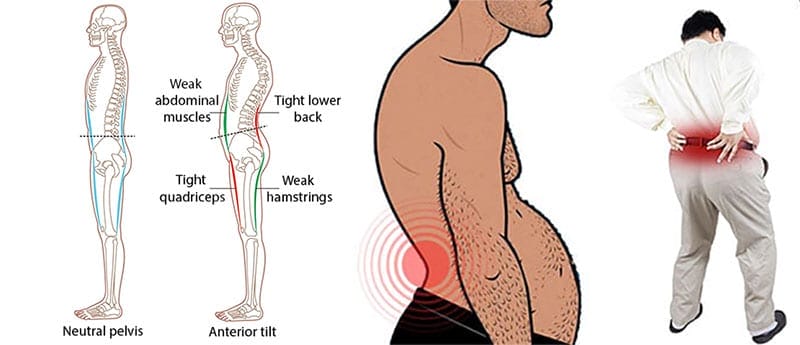
Many children suffer problems without even knowing. For example, this study tested the back health of 154 ten-year-old kids. Nine percent were found to be suffering from spinal disc degeneration. None had a history of back pain. All were asymptomatic.
Life with spinal disc degeneration
The effects of spinal disc degeneration only begin to show from the late teens to early 30s.
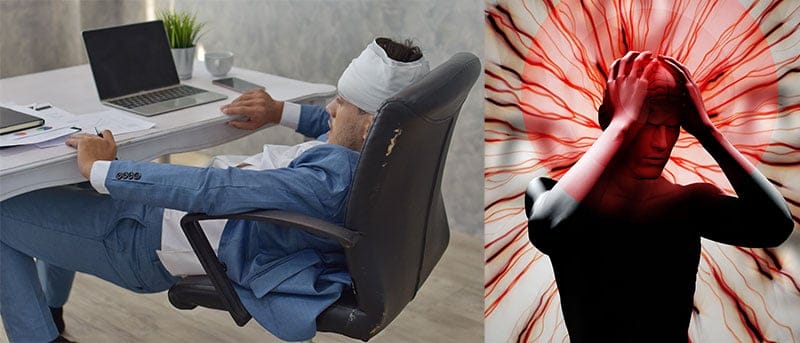
Non-stop lower back pain and chronic fatigue are the primary symptoms. Common symptoms:
- Pain increases after sitting for long periods. With (non-seated) rest, it goes away.
- Running, walking, or changing positions reduces pain.
- Pain gets worse when twisting, being, or picking up heavy objects.
- As the pain gets worse, it radiates to other areas of the body.
This effectively means a child can slouch for twenty years before chronic pain kicks in. That opens the floodgates for a host of other issues.
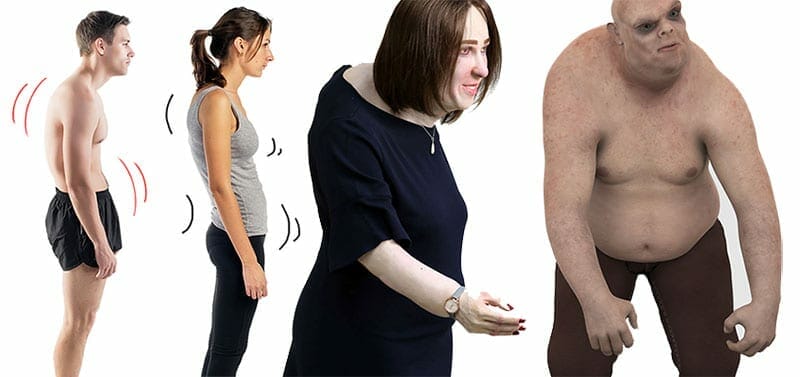
Here are common ailments that chronic poor posture causes in adults:
- Chronic fatigue: imbalanced posture overworks body parts not meant to bear weight. To compensate, muscles overwork to the point of fatigue. Extended muscular fatigue wears down joints and ligaments, leading to even greater imbalances. With greater imbalances comes greater energy demands and perpetual exhaustion.
- Slower digestion: poor posture compresses lower intestines. That moves food slower through the system, causing bloating and constipation. Poor posture can also cause incontinence and heartburn triggered by acid reflux.
- Depression: many studies suggest a link between poor posture and negative emotions. For example, those who sit straight tend to be more alert, positive and energetic. Those who slouch tend towards apathy and negative thinking.
- Chronic headaches: slouching forces a forward head posture that stresses neck muscles. With extended stress, pain flares up in the neck, then radiates up towards the head. The more you slouch, the worse the migraines.
Conclusion
Special thanks to The Rise and Fall of American Posture (by David Yosifon and Peter N. Stearns). This 39-page journal article first appeared in the American Historical Review (Vol. 103, No. 4 (Oct., 1998), pp. 1057-1095). The article makes clear:
The American education system has no idea about healthy student seating.
If your child is bloated, listless, depressed, or constipated, their sitting habits might be the problem. The education system is not equipped to help.

Recently, ChairsFX spoke with TechLead (former tech lead at Google and Facebook). He warned that in the corporate world, no one is equipped to help with ergonomics either:
“Programmers need to actively take care of themselves because the company won’t be looking out for you… It’s up to you to identify whether you need a more ergonomic chair, desk, leg rest, wrist pad, etc.”
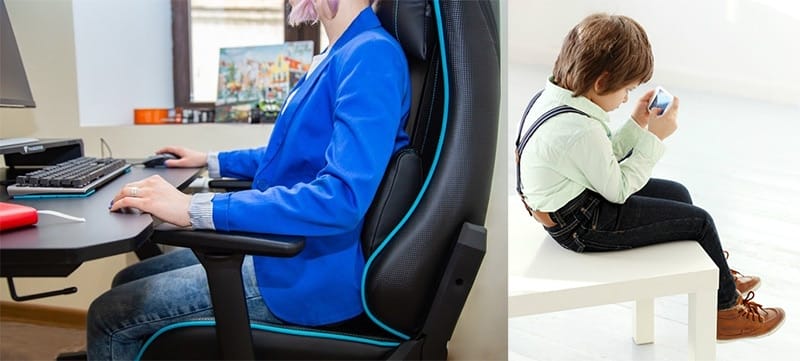
Given the rise in study-from-home injuries, the future is now. In simple terms, non-ergonomic chairs are bad for your back. In comparison, gaming chairs (and other types of ergo chairs) are (potentially) good for your back.
Footnotes
- Bianca Navas. ‘[Opinion] School chairs have negative effects on teenage posture’. October 15, 2018. https://eagleeye.news/7613/opinion/school-chairs-have-negative-effects-on-teenage-posture/, (accessed 25 November, 2023).
- Linda Perlstein. ‘Is the best way to fix the American classroom to improve the furniture?’. October 26, 2010. https://slate.com/news-and-politics/2010/10/is-the-best-way-to-fix-the-american-classroom-to-improve-the-furniture.html, (accessed 25 November, 2023).
- Nema Nyar. ‘Why Posture Matters’. September 16, 2019. https://himalayaninstitute.org/online/why-posture-matters/, (accessed 25 November, 2023).
- Calodagh McCumskey. ‘The benefits of achieving good posture’. July 14, 2018. https://www.independent.ie/regionals/wicklow/bray-news/the-benefits-of-achieving-good-posture/37103775.html, (accessed 25 November, 2023).
- Vivian Giang. ‘The Surprising And Powerful Links Between Posture and Mood’. October 30, 2015. https://www.fastcompany.com/3041688/the-surprising-and-powerful-links-between-posture-and-mood, (accessed 25 November, 2023).
- D Yosifon, et al. ‘The rise and fall of American posture’. 1988, Am Hist Rev. 1998;103(4):1057-95. PMID: 11623977, (accessed 25 November, 2023).
- The American Board. ’11 Facts About The History of Education in America’. July 1, 2015. https://www.americanboard.org/blog/11-facts-about-the-history-of-education-in-america/, (accessed 25 November, 2023).
- State University. ‘Common School Movement’. https://education.stateuniversity.com/pages/1871/Common-School-Movement.html, (accessed 25 November, 2023).
- Kerry McDonald. ‘Compulsory Schooling Laws Have Got To Go’. August 22, 2023. https://fee.org/articles/compulsory-schooling-laws-have-got-to-go/, (accessed 25 November, 2023).
- Katherine Unger Baillie. ‘Examining 20th-century America’s obsession with poor posture, a forgotten ‘epidemic’. June 7, 2018. https://penntoday.upenn.edu/news/examining-20th-century-americas-obsession-poor-posture-forgotten-epidemic, (accessed 25 November, 2023).
- Gulick, Luther Halsey. ‘American physical education review’. Published 1885. https://catalog.hathitrust.org/Record/000494070, (accessed 25 November, 2023).
- Jessie Hubbell Bancroft. ‘The Posture of School Children’. Published 1913. Google Scholar Listing, (accessed 25 November, 2023).
- Ron Rosenbaum. ‘The Great Ivy League Nude Posture Photo Scandal’. January 15, 2015. https://www.nytimes.com/1995/01/15/magazine/the-great-ivy-league-nude-posture-photo-scandal.html, (accessed 25 November, 2023).
- Advisory Board. ‘Text neck, selfie elbow, and cracked teeth: These injuries are surging as more Americans work from home’. January 19, 2021. Read the archived version, (accessed 25 November, 2023).
- Jennifer Pynt. ‘Seeking the Optimal Posture of the Seated Lumbar Spine’. January 2001. https://www.researchgate.net/publication/224029048_Seeking_the_Optimal_Posture_of_the_Seated_Lumbar_Spine, (accessed 25 November, 2023).



